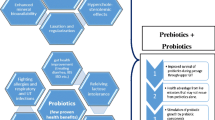Abstract
The effects of fiber isolated from black gram (Phaseolus mungo) and Coconut (Cocos nucifera) kernel on the metabolic activity of intestinal and fecal beta glucuronidase activity during 1,2-dimethylhydrazine induced colon carcinogenesis were studied. The results indicated that the inclusion of fiber from black gram and coconut kernel generally supported lower specific activities and less fecal output of beta-glucuronidase than did the fiber free diet. This study suggests that the fibers isolated from coconut or black gram may potentially play a role in preventing the formation of colon tumors induced by the carcinogen 1,2-dimethylhydrazine by reducing the activity of the intestinal as well as fecal beta-glucuronidase.
Similar content being viewed by others
References
Hambly RJ, Rumney CJ, Fletcher JM, Rijken PJ, Rowland IR (1997) Effects of high and low-risk diets on gut microflora-associated biomarkers of colon cancer in human flora-associated rats. Nutr Cancer 27: 250-255.
Shian SY, Chang GW (1983) Effects of dietary fiber on fecal mucinase and glucuronidase activity in rats. J Nutr 113: 138-144.
Mallett AK, Rowland IR, Farthing MJ (1987) Dietary modification of intestinal bacterial enzyme activities — potential formation of toxic agents in the gut. Scand J Gasterol Suppl 129: 251-257.
Gestel G, Besancon P, Rouanet JM (1994) Comparative evaluation of the effects of two different forms of dietary fiber (rice bran vs wheat bran) on rat colonic mucosa and faecal microflora. Ann Nutr Metab 38: 249-246.
Reddy BS, Weisburger JH, Wynder EL (1974) Fecal bacterial beta glucuronidase: Control by diet. Science 183: 416-417.
O'Neill IK, Bingham S, Povey AC, Brouet I, Bereziat JC (1990) Modulating effects in human diets of dietary fiber and beef and of time and dose on the reactive microcapsule trapping of benzo(a)pyrene metabolites in the rat gastrointestinal tract. Carcinogenesis 11: 599-560.
Hill MJ (1975) The role of colon anaerobes in the metabolism of bileacids and steroids and its relation to colon cancer. Cancer(Phila) 36: 2387-2400.
Kesteloot H, Lesaffre E, Joossens JV (1991) Diary fat, saturated animal fat and cancer risk. Prev Med 20: 226-236.
Reddy BS, Mangert S, Weisbunger JH, Wynder EL (1977) Effect of high risk diets for colon carcinogenesis on intestinal mucosal and bacterial glucuronidase activity in F344 rats. Cancer Res 37: 3533-3536.
Glodia B, Gorbach SI (1976) The relationship between diet and rat fecal bacterial enzymes implicated in colon cancer. J Natl Cancer Inst 57: 371-375.
Wynder WL, Reddy BS (1974) Metabolic epidemiology of the colorectal cancer. Cancer 34: 806.
Burkitt DP (1971) Epidemiology of cancer of the colon and rectum. Cancer (Phila) 28: 3-13.
Rao CV, Chou D, Simi B, Ku H, Reddy BS (1998) Prevention of colonic aberrant crypt foci and modulation of large bowel microbial activity by dietary coffee fiber, inulin and pectin. Carcinogenesis 19: 1815-1819.
Cohen LA, Zhao Z, Zang EA, Wynn TJ, Simi B, Riverson A (1996) Wheat bran and psyllium diets: Effects on N-Methylnitrosourea induced mammary tumorogenesis in F344 rats. J Natl Cancer Inst 88: 899-907.
Fiala ES (1977) Investigations into the metabolism and mode of action of the colon carcinogens 1,2-dimethylhydrazine and azoxy methane. Cancer(Phila) 40: 2436-2445.
Bauer HG, Asp NG, Oste R, Dahlquist A, Fredlund PE (1979) Effect of dietary fiber on the induction of colorectal tumors and fecal beta glucuronidase activity in the rat. Cancer Res 39: 3752-3756.
Manoj G, Harikumaran Thampi BS, Leelamma S, Venugopal P Menon (1993) Dietary fiber and activity of intestinal tissue beta-glucuronidase in rats. Nutr Res 13: 575-582.
Indira M, Vijayammal PL, Menon PVG, Kurup PA (1980) Effect of dietary fiber on intestinal bacterial beta-glucuronidase activity in chicks fed cholesterol containing diet. Cancer 66: 2430-2432.
Goering HK, Van Soest PJ (1970) Forage Fiber Analysis: Agricultural Analysis. Agricultural Hand Book 379. US Department of Agriculture: Agricultural Research Service.
Kawai Y, Anno K (1971) Mucopolysaccharide degrading enzymes from the liver of the squid, Quammastrephes solani Panclificus. Biochim Biophys Acta 242: 428-432.
Bannat CA, Franklin NL (1967) Statistical Analysis in Chemistry and Chemical Industry. New York, USA: John Wiley & Sons.
Weisbunger JH, Willions GM (1975) Metabolism of chemical carcinogens. In: Becker FF (ed), Cancer: A Comprehensive Treatise, Vol 1. New York: Plenum Press, pp 185-231.
Author information
Authors and Affiliations
Rights and permissions
About this article
Cite this article
Manoj, G., Thampi, B., Leelamma, S. et al. Effect of dietary fiber on the activity of intestinal and fecal beta-glucuronidase activity during 1,2-dimethylhydrazine induced colon carcinogenesis. Plant Foods Hum Nutr 56, 13–21 (2001). https://doi.org/10.1023/A:1008188009174
Issue Date:
DOI: https://doi.org/10.1023/A:1008188009174




